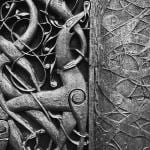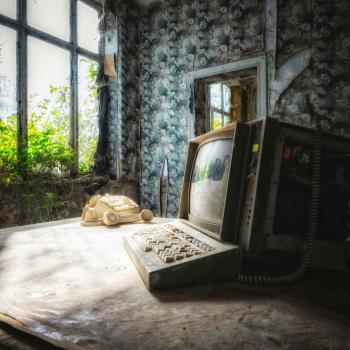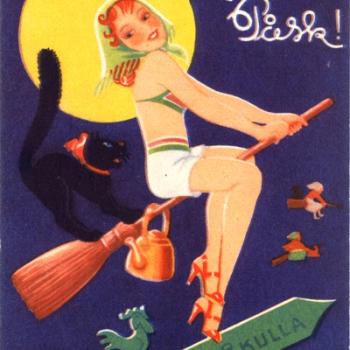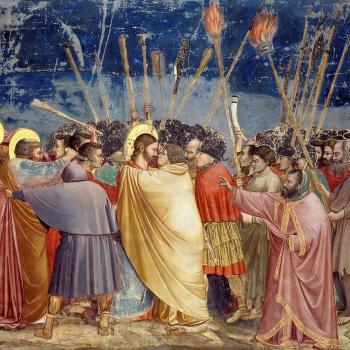Earlier this year, Raven Grimassi passed across the veil. I have followed Grimassi’s writings with interest, and supported him in the past with various projects. The only caveat is to say that I have sometimes felt an unease with regard some aspects of his Italian Witchcraft output, it not being an area I am especially versed in myself. Indeed, many credit Grimassi with popularising the idea of Stregheria, Italian witchcraft, and propagated a tradition that curiously appeared to blend Wicca, Leland’s Aradia and Italian folkloric elements. More recently, Grimassi has attracted attention in Traditional Witchcraft circles with his writings. Whatever people’s feelings or thoughts on Grimassi, he was a real advocate for witchcraft traditions and wrote with an influential and worthy voice, especially in today’s pop witchcraft culture.
That being said, I was simultaneously interested in, and fearing critiquing, Raven Grimassi’s last book, What we Knew In the Night. It was a great surprise, however, when I flicked through to find more than a few pages which immediately leapt out and spoke of a witchcraft familiar and older than that often popularised today. Holding the book in my hands for the first time, scanning the bibliography (I like to know who an author is drawing from, and what titles…), I suddenly found myself anticipating future reference material. The first brief appraisal, utterly out of the blue, suggested more than the hint of a work that speaks of witchcraft as it was in the last half of the 20th century and, perhaps more importantly, how this is relevant today.

The introduction and entry to the first chapter are a timely and much-needed harkening to the witchcraft of the last century, reconciling this with the Craft that forms the basis of today’s interpretations. This is well received and it is a pleasure to hear echoes of the 1960s reverberate with such vigour. Indeed, talk of such things as Virtue and the Watchers in this context is a welcome re-introduction to today’s Craft.
The introduction and entry to the first chapter are a timely and much-needed harkening to the witchcraft of the mid-twentieth century
Unfortunately, we are then introduced to seemingly new ideas and somewhat far-fetched notions such as ‘wafting’. This, we are told, is ‘… an occult energy that is part of the nature of night itself in the Witch’s world.’ The harvesting of this ‘energy’ is one of those additions that requires something of a fanciful way of looking at witchcraft, in this writer’s opinion, and can be done away with in favour of the more appreciable inclusions within What we Knew in the Night.
There follows in the chapter a discourse of plant and herb lore, culminating in the classic root of witchery, the Mandrake. With a smattering of Aradia throughout, we travel through concepts such as Drawing Down the Moon, which has been interpreted in differently by those who propagated witchcraft in the early days of the 1960s. Grimassi adds a fairly succinct summary of the historical ideas, while avoiding emphasis of either a Wiccan or Cochranian rendition. Quickly upon the heels of this is the subject of the crossroads, a staple of witchcraft lore, and the reiteration of the use of the Watchers.
Chapter Three is a journey of exploration which takes in the landscapes of the multiple worlds encountered in witchcraft, from the Astral and Elemental, the Witch’s Circle as well as Familiar spirits. Most interesting, and once again referencing an old idea from the 1960s and one which Robert Cochrane refers to (in letter to Joe Wilson[1]), is the section that talks of the ‘Voice of the Wind’. Listening to the wind is briefly, but quite ably, surveyed, best summarised by the idea that this is ‘…a receptive state… in which the Witch comes to personal gnosis.’

The subsequent chapters are a refreshing overview of witchcraft ideas and lore which are a welcome addition to the modern popular literature on the subject, from a person who demonstrably knew and understood such things. Raven Grimassi was evidently well read in the subject and references works such as Bill Gray’s Western Inner Workings, a significant and valuable book that aids in approaching Traditional Witchcraft, as well as Paul Huson’s seminal and classic work, Mastering Witchcraft. Indeed, Grimassi’s final literary work is a fantastic summation of witchcraft as it was in the early days, and as experienced by the author, and reaffirms ideas that might be placed under the category of Traditional Witchcraft today but were, in fact, merely called ‘witchcraft’ back in the day. Such ideas were rarely referred to in the books that thereafter issued forth and, by the present time, modern writers might be forgiven for not having encountered some of these things prior to this book. For these, and other reasons, What we Knew in the Night is a book that is recommended and is a superb testament to a man who committed his life to the Craft and was a worthy champion. He will be missed by many, but his last contribution to the community is set to be an important addition to the reading lists of many witches, old and new.

[1] “The answers to all things are in the Air – Inspiration, and the Winds will bring you news and knowledge if you ask them properly.” – Robert Cochrane, letter to Joe Wilson


















